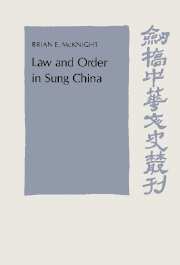Book contents
- Frontmatter
- Contents
- List of figures, maps, and tables
- Preface
- List of abbreviations
- 1 Introduction
- 2 The historical context
- 3 Crimes and criminals
- 4 Informal and semiformal agencies of law enforcement
- 5 Formal civil agencies of law enforcement
- 6 The role of the military in law enforcement
- 7 Supervision of law enforcement – the role of the intendants
- 8 Personnel selection
- 9 Urban crime and urban security
- 10 The Sung penal system
- 11 Jails and jailers in the Sung
- 12 Penal registration
- 13 The death penalty
- 14 Modifications of penalties
- 15 Conclusion
- Glossary
- Bibliography
- Index
5 - Formal civil agencies of law enforcement
Published online by Cambridge University Press: 23 December 2009
- Frontmatter
- Contents
- List of figures, maps, and tables
- Preface
- List of abbreviations
- 1 Introduction
- 2 The historical context
- 3 Crimes and criminals
- 4 Informal and semiformal agencies of law enforcement
- 5 Formal civil agencies of law enforcement
- 6 The role of the military in law enforcement
- 7 Supervision of law enforcement – the role of the intendants
- 8 Personnel selection
- 9 Urban crime and urban security
- 10 The Sung penal system
- 11 Jails and jailers in the Sung
- 12 Penal registration
- 13 The death penalty
- 14 Modifications of penalties
- 15 Conclusion
- Glossary
- Bibliography
- Index
Summary
Role of the sheriff
Although they were clearly important to the general processes of keeping order, the village officers and militia personnel were hardly powerful enough to handle serious disorders by themselves, nor were they allowed to fetter people or hold them in detention. The superiority of their sources of information and the advantage of being close to the scenes of the crimes were offset by their inadequate arms, training, and leadership. Therefore, above them the formal state apparatus took over the problem, using both civil officers and the military. A wide variety of officials and officers had some responsibilities for law and order during the Sung, the two most important field-level offices being the (civil) district sheriff (hsien-wei) supported by a group of several dozens of civilian constables called archers (kung-shou) and the (military) patroling inspector (hsün-chien) with perhaps one hundred regular soldiers under his command; on the supervisory level most tasks were eventually the concern of the circuit intendants. Though such formal agencies could not be spread as widely as village officers, the authorities did station them at critical points where their very presence might deter lawbreaking. Sheriffs were usually stationed at the towns that were the district seats and sometimes at other towns. The patroling inspectors were mostly commonly stationed in forts located at dangerous and strategic places in the rural areas. Both sorts of officers on occasion were headquartered at other population centers such as fords, bridges, and markets. Finally, small complements of soldiers with law-enforcement duties were stationed at the postal stations that dotted the transportation routes.
- Type
- Chapter
- Information
- Law and Order in Sung China , pp. 147 - 190Publisher: Cambridge University PressPrint publication year: 1992

